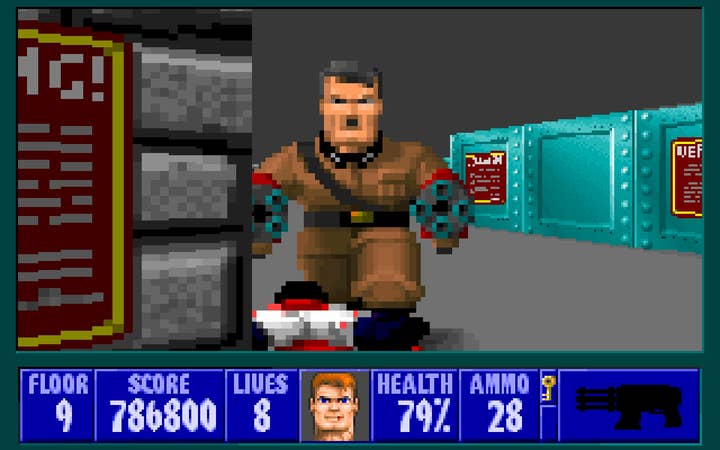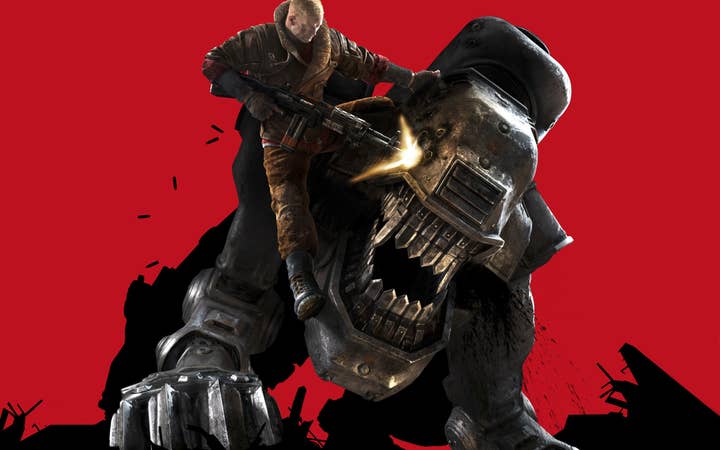A short history of banned games in Germany
Beiten Burkhardt's Andreas Lober explores Germany's fractious relationship with video games -- and the age rating issues that still lie ahead
For decades, Germany's Youth Protection Laws have been the strictest in the world. In the '80s, they brought us green blood in games. Sometime in the '90s, they became the worldwide gold-standard: If you were compliant in Germany, you could be pretty sure to be compliant elsewhere.
In the last couple of years, they became more liberal -- even Wolfenstein got rated. And just when publishers started to think that anything goes, a new draft law was presented by the ministry. If it is adopted, it will be a game-changer. Time to have a closer look at what has happened over the years and why Germans now think that Nazis are less problematic in video games than loot boxes.
Blood is not always red
The most infamous era of Youth Protection in Germany was the '80s. Existing laws were applied to games, and the supervising state authority "Bundesprüfstelle für Jugendgefährdende Schriften" (Federal Department for Media Harmful to Young People) was putting games in a so-called index.
Time to have a closer look at why Germans now think that Nazis are less problematic in video games than loot boxes
This meant that restrictions on distributing these games were so heavy they pretty much disappeared from the shelves, and became even more popular as pirate copies. They included classics such as Operation Wolf, Green Beret and Who Dares Wins, as well as more provocative titles such as Raid Over Moscow and Friday the 13th, and outright rubbish such as Hitler Diktator.
In order to avoid the commercial death of their products, publishers became creative: Wherever possible, they were looking for ways to adapt their products to avoid upsetting the regulator -- replacing red blood with green blood was among the more popular measures. Space Invasion -- not to be confused with Space Invaders -- was a game specially produced for the German market, and was basically a (slightly) reskinned version of Commandos in which you fought aliens instead of human beings, with the cries of agony removed.
It was in that period the president of the Bundesprüfstelle became public enemy number one for hardcore gamers, who felt the authority lacked an appropriate understanding for the new medium. Some of the more controversial IPs of the late '80s and early '90s have survived until today: Wolfenstein, Doom, Quake, and Duke Nukem 3D were all de facto banned and dubbed "killer games" by mainstream media.
The distribution of "Wolfenstein 3D" was even held to be a criminal offense by the courts, partly because it featured swastikas galore. Unsurprisingly, this resulted in a debate: Can it be illegal to kill Nazis? Yes, the court said, as it should not be seen as normal or entertaining to see Nazi symbols.

From curiosity to gold standard
It was later in the '90s, when violence in games became more realistic, that German Youth Protection Laws gradually became something like the global standard. This was at least partly thanks to a revision of the Youth Protection Law, and as a consequence, the industry's self-regulating age-rating body Unterhaltungssoftware Selbstkontrolle (USK) was established in 1994.
In order to freely distribute games in retail, a USK rating became mandatory. Games that were rated could not be banned by the Bundesprüfstelle, but the USK was not allowed to rate games which potentially fulfilled the criteria of being banned by the Bundesprüfstelle. This balance of power still exists today. While it seems complex at first, it ensured a huge number of games were rated by the USK, which led to a lot of case law -- this greatly helped to define ratings criteria, and the ratings were less random than the early decisions of the Bundesprüfstelle.
Wolfenstein, Doom, Quake, and Duke Nukem 3D were all de facto banned and dubbed "killer games" by mainstream media
Gratuitous violence, a high frequency of killings, or extreme violence against humans became the main reasons for the USK to refuse a rating, and the Bundesprüfstelle banning games. When graphics and physics engines evolved, ragdoll effects and dismemberment effects became important factors in why the USK refused a rating, and why the Bundesprüfstelle put games on the index. While violence against humans was generally considered more problematic than violence against non-humans, "human-like" creatures such as zombies were treated just as humans -- the Dead Rising series or Killing Floor were not rated by the USK, and de facto banned by the Bundesprüfstelle.
Publishers, of course, reacted on the requirements of one of the world's biggest markets for games. They released "German versions" of the games where, in cases such as Command & Conquer 2 and Half Life, enemies were turned into robots. In other games -- again including Half-Life -- the color of human blood was changed for Germany, or blood was entirely removed. Unsurprisingly, these versions proved to be less popular, and websites emerged that explained how the changes could be reversed.
Publishers gradually tried to design games in a way that would get a rating in Germany -- so they could also label them "uncut" for the German market. Arguably, this had an impact on game design globally to a certain extent, and not just visuals: Having non-violent gameplay elements helped to get rated by the USK, and games with a particularly high frequency of killings did not get rated. Serious Sam-style gameplay, therefore, was not helpful, and this might be one reason why some shooters started to include more puzzle elements.

Online trouble
One of the loopholes of the youth protection regime became apparent in the '00s. The law described so far (Jugendschutzgesetz) only applies to games sold on physical media -- not for online media. The latter did not -- and still does not -- require a rating, though many publishers had their games rated anyway. The second problem was -- and to a certain extent still is -- the consequences of that rating: How do you effectively implement age verification or age gates in an online environment?
The relevant legislation (Jugendmedienschutz-Staatsvertrag) suggests restricting "broadcasting times"" for 16+ content and 18+ content to the evening -- which, obviously, works much better for television than it does for games. A technical solution for the problem was found: filter software, the only approved one being JusProg these days.
Wind of change

As far as ratings criteria go, the last couple of years have been pretty liberal. The de facto ban that had been imposed by the Bundespüfstelle was lifted for many games, including Doom, Doom 2, Quake, Quake 2, Fallout 3, Gears of War, Gears of War 2, several Grand Theft Auto games, and Max Payne.
For the latter, the "bullet time" visuals were originally one of several reasons for putting the game on the index -- later, it was considered one of the reasons for lifting the ban. Originally, "bullet time" was held to be very violent, and it was then held to be unrealistic. It came as a surprise to many that Mortal Kombat X was not put on the index. The reason: the violence in the game was so extreme that it could hardly be considered realistic. The longstanding dogma that considered zombies to be "human-like" was reversed as well -- Dead Rising 4 and State of Decay 2, for example, were rated 18+ by the USK.
Then came the Nazi symbols. The USK changed its policy, which formerly said that it never rated games with Nazi symbols, and now looked at games on a case-by-case basis. The decisive criteria was whether the content was socially adequate -- this, essentially, means that games taking a clear stance against Nazis can use these symbols.
This was first applied to Through the Darkest of Times and Attentat 1942, then confirmed by USK and Bundesprüfstelle for Wolfenstein 2. Games that do not take such a clear position, though, still must not use Nazi symbols.
One of the remaining problems that needs to be solved is the enduring distinction between retail games and online games
With all this liberalisation, some publishers seem to have thought that now "everything goes" -- only to find themselves with unexpected rating troubles. USK and Bundesprüfstelle now often find sexual poses in anime games problematic, and there are still games where the level of violence is too high to justify a USK rating. Another topic currently on the agenda are gambling mechanisms in certain games.
Trouble ahead
One of the remaining problems that needs to be solved is the enduring distinction between retail games and online games. This is not an easy task, as the competence for regulating online games lies with the states of Germany (the Länder), not on the federal level.
In an attempt to unify the regime, the Federal Ministry for Family Affairs, Senior Citizens, Woman and Youth has recently presented a draft for a new law. This attempt to harmonise the system can only be praised. Unfortunately, the draft is ill-designed in some respects.
Essentially, it tries to resolve a lot of other issues, ranging from data protection (as if GDPR was not enough), to in-game purchases by minors (which are void anyway), to addiction, cyber-mobbing, and cyber-grooming. While all of these issues are real problems, the proposed solution certainly is not a good idea.
The draft wants to take all of these factors into account for an age rating. However, there are much better instruments to tackle extensive play than to give engaging games a high rating -- for example, Nintendo Switch's parental controls. And with regard to cyber-mobbing and cyber-grooming, the people responsible for the draft seem to not be knowledgeable enough (or just too arrogant) to look at which systems already exist beyond the borders of Germany, such as the Children's Online Privacy Protection Act (COPPA). Adapting an established system certainly would be a better idea than completely devalues the existing age labels.
Here is a list of the most important points for the games industry that are currently on the table:
- Expansion of the Youth Protection Act to cover online media, including online games.
- New age rating criteria, such as extensive use of personal data, enticement to disclose personal data, addictive qualities of the game, gambling mechanisms, unlimited ingame purchases, and unrestricted communication. The rating might also depend on the features of the distribution platform.
- Recommendation or even obligation to label games with symbols indicating "the main reasons for the age rating" and the "potential impairment" of minors -- so called "descriptive symbols".
- Obligation for "game platforms" with more than one million users in Germany to clearly label games with an age rating. According to the draft act, such labels could also be issued by an "automatic rating system" provided by a self-regulatory body on basis of an agreement with the competent authorities in the future -- the International Age Rating Coalition (IARC) might potentially be recognized, for example.
- Youth protection by design and by default -- media providers with more than one million users in Germany who also address minors must take "appropriate and effective structural measures" to safeguard the goals of the act.
Dr Andreas Lober is partner at the law firm Beiten Burkhardt. He has been advising video game companies for many years. The views expressed in this article are his personal opinions, memories and conclusions. They are certainly not complete, and probably biased towards games he loved to play himself in his youth, or where he assisted the publisher in lifting a ban or getting a USK rating -- such as Doom, Quake, Wolfenstein 2 and Dead Rising 4.
